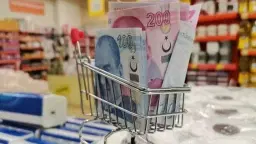We hope for the help of cosmetics as we cannot lower production costs. But if you overuse the cosmetics, the face will be ruined.
Turkey is the fifty first among 182 countries in the ranking of price increases in the period between the beginning of 2005 and the end of 2011. If the ranking is revised on the basis of the rate of inflation in an ascending order, Turkey becomes the 132nd. In short, although we have left behind the high inflation rates of the 1990s, we are not at a good position in this league since other countries fighting with high inflation also succeeded. The beginning of the analysis period is 2005 because it is the year when six digits were omitted from the Lira. This preference of course has a particular importance: “I want to put a bug in ears.” I do not know if I can succeed, but it does not matter anyway. Let me dig into the inflation ranking with reference to Turkey’s competitiveness.
The relegation zone

Source: IMF World Economic Outlook database
The table above more or less involves Turkey’s rivals in export markets, though some of you might disagree. There are two columns following the name of each country. First shows the annual increase in consumer prices between the beginning of 2005 and the end of 2011 and the second between the beginning of 2009 and the end of 2011. Of course, the year 2011 has not ended yet. The figures for 2011 reflect the IMF’s estimations announced in October in line with recent developments. Turkey is among the first eighteen “teams”, say as in the Turkish football league, the super league. Countries are ranked in ascending order on the basis of the inflation rates in the 2005-2011 period. So assume that this is the table of the “emerging market economies competitiveness league”. Unfortunately, Turkey is right above the relegation zone. Of course it is still an honor to play in the second league. Also, some of the goods involved in the consumer price basket are not in the export basket and thus this ranking based on consumer prices will not allow a sensitive comparison. Still, it gives an intuition. This ranking shows that Turkey produces goods and services at a higher cost compared to its rivals. As a result, we rely on the exchange rate to gain an advantage in export markets. We hope that the Lira depreciates and thus Turkish products become relatively cheaper in foreign exchange (FX) terms.
Hoping for the help of make-up
In a way, we hope for the help of cosmetics as we cannot lower production costs. The cosmetics here are tools that push up the exchange rate. If you overuse cosmetics, the face will be ruined. Prices (the face) will increase further. But why did we put on the make-up in the first place? To lower the FX price of goods produced with higher costs compared to rivals so that exports can increase. What happened in the end? Export goods became more expensive in Lira terms, requiring more make-up. Then, we started to worry about the “form the face might take” when more make-up is put on and tried to wash off the make-up with a power wash (exchange rate intervention). OK, but isn’t there another way of controlling the rise in production costs (inflation) without using cosmetics or power wash? What methods do the countries in the upper ranks use?
This commentary was published in Radikal daily on 10.11.2011





